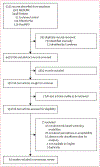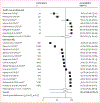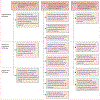Acceptability and perceptions of personalised risk-based cancer screening among health-care professionals and the general public: a systematic review and meta-analysis
- PMID: 39909697
- PMCID: PMC11817692
- DOI: 10.1016/S2468-2667(24)00278-0
Acceptability and perceptions of personalised risk-based cancer screening among health-care professionals and the general public: a systematic review and meta-analysis
Abstract
Background: Personalised risk-based screening (PRBS) can enhance the efficiency of cancer screening programnes, but little is known about support for its implementation among the general public and health-care professionals. We aimed to summarise the acceptability and perceptions of PRBS for breast, cervical, colorectal, lung, and prostate cancer screening among these groups.
Methods: We conducted a systematic review and meta-analysis of original research studies reporting on breast, cervical, colorectal, lung, and prostate cancer screening; personalised risk assessments to guide PRBS; and the acceptability of and receptibility towards these approaches among the general public, health-care professionals, or both. We searched MEDLINE, Embase, Cochrane Central, PsycINFO, and CINAHL Plus for articles published between Jan 1, 2010, and April 30, 2024. Studies not reporting on the outcomes of interest and with insufficient data for analysis were excluded. Six reviewers independently screened articles, and risk of bias was assessed using the Mixed Methods Appraisal Tool. Qualitative data were analysed thematically. Quantitative data were analysed with use of random-effects meta-analysis for outcomes that had at least two studies. The study protocol was registered at PROSPERO, CRD42022354287.
Findings: Our search identified 4491 unique records. After screening, 63 studies were included in our analysis, of which 36 (57%) included the general public, 21 (33%) included health-care professionals, and six (11%) included both. The majority of studies focused on breast cancer screening (43 [68%] studies), and were from North America (28 [44%]) and Europe (28 [44%]). Qualitative findings were analysed thematically, and the extracted quantitative findings were synthesised under the following topics: acceptability and perceptions of personalised risk assessments among the general public; acceptability and perceptions of PRBS among the general public; acceptability and perceptions of PRBS among health-care professionals; and barriers and facilitators to PRBS implementation among health-care professionals. The general public and health-care professionals generally found PRBS acceptable, but they needed more information about how risk was calculated and the accuracy of risk scores. Additionally, both groups were cautious about reducing screening frequencies for individuals at low risk and cited barriers such as the time and resources needed to implement an effective PRBS programme. The pooled estimate for acceptability of PRBS was 78% (95% CI 66-88) among the general public and 86% (64-99) among health-care professionals.
Interpretation: The general public and health-care professionals both viewed personalised risk assessments as providing valuable information and PRBS as a logical next step to increase the quality of patient care and improve cancer mortality. However, implementation barriers at the public, health-care professional, and system level need to be addressed.
Funding: National Cancer Institute and Cancer Prevention and Research Institute of Texas.
Copyright © 2025 The Author(s). Published by Elsevier Ltd. This is an Open Access article under the CC BY 4.0 license. Published by Elsevier Ltd.. All rights reserved.
Conflict of interest statement
Declaration of interests We declare no competing interests.
Figures
References
-
- Smith RA, Manassaram-Baptiste D, Brooks D, et al. Cancer screening in the United States, 2015: a review of current American cancer society guidelines and current issues in cancer screening. CA Cancer J Clin 2015; 65: 30–54. - PubMed
-
- US Preventive Services Task Force. Breast cancer: screening. April 30, 2024. https://www.uspreventiveservicestaskforce.org/uspstf/recommendation/brea... (accessed May 23, 2024).
-
- US Preventive Services Task Force. Cervical cancer: screening. Aug 21, 2018. https://www.uspreventiveservicestaskforce.org/uspstf/recommendation/cerv... (accessed May 23, 2024).
-
- US Preventive Services Task Force. Colorectal cancer: screening. May 18, 2021. https://www.uspreventiveservicestaskforce.org/uspstf/recommendation/colo... (accessed May 23, 2024).
-
- Wolf AMD, Wender RC, Etzioni RB, et al. American Cancer Society guideline for the early detection of prostate cancer: update 2010. CA Cancer J Clin 2010; 60: 70–98. - PubMed
Publication types
MeSH terms
Grants and funding
LinkOut - more resources
Full Text Sources
Medical
Miscellaneous




